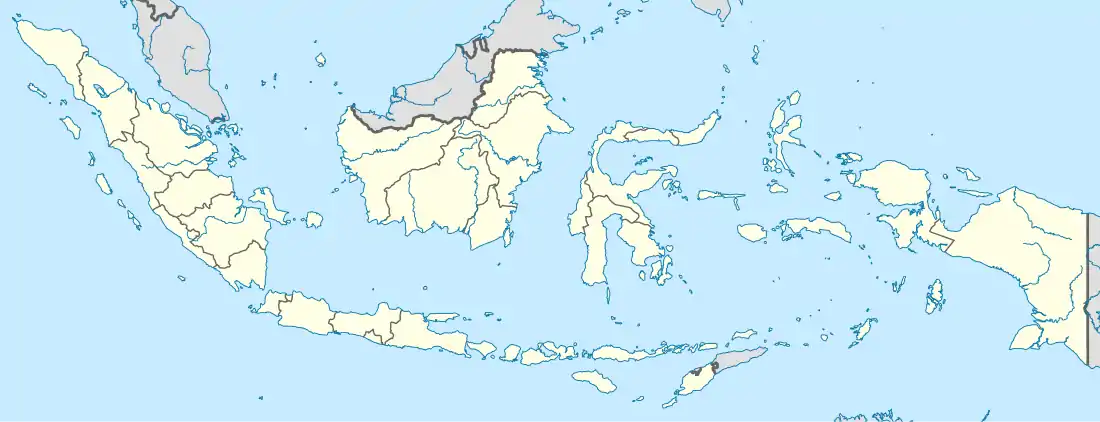Lebak Cibedug
Lebak Cibedug temple, is a terraced pyramid shaped sacred ancient Hindu and megalithic site on the bank of Cibedug river near Citorek village in Banten regency of West Java province of Indonesia. There are other megalithic menhirs and Dolmens on this site.[1][2]
| Lebak Cibedug Pyramid Hindu temple | |
|---|---|
 Location within Java  Lebak Cibedug (Indonesia) | |
| Location | Banten, West Java, Indonesia. |
| Coordinates | |
It is counted among the 5 known terraced monolithic pyramids in Indonesia, all of which are Hindu sites built during Hindu-Buddhist era, other being Candi Kethek, Gunung Padang Megalithic Site, Pugung Raharjo and Candi Sukuh.[1]
Location
Citorek is 130 km southwest of Jakarta airport via Indonesian National Route 1 till Balaraja and then south via Jalan Raya Maja and Jalan Raya Cipnas to Citorek. Citorek is 90 km west of Bogor city via Indonesian National Route 11 and then south via Jalan Sukajaya and Jalan Raya Cipnas to Citorek.
The forested site, surrounded by trees and volcanic andesite stones, is reached by 2 hour trekking from Citorek village to the smaller Cibedeg village in the west.[3] The Cibedeg village is administratively consider part of Citorek village.[2] Citorek is reachable by a paved road, after which the Cibedeg village and the Cibedeg archaeological site can be reached either by trekking on foot or by pillion riding the hired motorcycle taxis called "ojek".[4] The site is located on the slope of Pasir Manggu hill.[2] The path from Citorek to Cibedug monument is paved with stones pavement along the rolling hillocks and ridges and a suspension bridge which is accessible only by the two wheeled vehicles or trekkers.[4] After the suspension bridge the path is widens.[4] The path, made of slippery stones and clay has poor rain drainage, also has landslides point.[4] Near the monument is the Cibedug village which can be reached only on the foot.
Site is located in the forest next to the Mount Halimun Salak National Park.[2] other nearby attractions include beaches, such as Pulo Manuk, Ciantir and Tanjung Layar.[3]
History
It was mentioned in 's book "Megalithic Remains in South Sumatra".[1] It was used as a scared site by several Indianised hindu-buddhist kingdoms of the area, and tourists still offer prayers.[3] Native villagers can be hired as guides, who also explain the folklore related to the site.[3]
Architecture
Cibedug pyramid has nine terraces with menhirs and altars on them. Square shaped terraces were constructed with oval-shaped andesite stones.[5][6] This site is considered older than Gunung Padang Megalithic Site.[5][6] It was used as a sacred site.[5] Cibedug pyramid with nine terraces has typical east to west orientation of hindu temples, it can be climbed via the 33 steps of stairs made from andesite and clay boulders on its western side where the Cibedug river flows.[3][6] Couple of meters to the left before the entrance of stairs, there is an altar arrangement of 4 menhir stones, which are called "tukuh stone", '"scratched stone" and '"wells".[4] On the entrance of the stairs there is an upright menhir stone, 235 cm tall and 336 cm in diameter, which is the largest menhir on this site.[3][2] There are other menhirs and Dolmen littered around the area.[3][2]
On this 2 hectare site, west of pyramid is the Cibedug river. Before the entrance to the main pyramid, there are 2 more smaller megalithic platforms with only one and two terraces respectively.[3]
Influence on other temple's architecture
Lebak Cibedug monument design is older than the temples of Bali, and its design is considered the inspiration for designing the Pura Dalem Segara Madhu temple in Bali. "Lebak Cibedug temple's architectural concept of complex consisted different level terraces influenced many examples of Hindu / Buddhist temples in the Archipelago, and its influence still exists in large part of Hindu temples in Bali."[7]
Threats
Compared to other popular ancient Hindu-Buddhist tourist attractions in Indonesia, this is one of the oldest Hindu temple in Indonesia. Yet, this abandoned site is not managed by the government and there are no tourist facilities such as drinking water and restrooms.[3] Site is under threats[4] of erosion from rains, archaeological theft and vandalism, encroachment and damage by the forest vegetation, pollution due to lack of onsite visitor facilities, thus putting the site at the risk of disappearance. Site desperately needs excavation, historic identification and documentation, restoration, onsite management, security fence and guard, and ongoing archaeological study and upgrades to protect this ancient heritage of Indonesia.[4]
See also
- Pyramid temples in Indonesia
- Gunung Padang Megalithic Site, 5 terraces
- Candi Kethek, 5 terraces
- Pugung Raharjo, 5 terraces
- Candi Sukuh, 3 terraces
- Related topics in Java
- Candi Ceto
- Candi of Indonesia
- Prambanan Temple, 6th-9th century UNESCO heritage Hindu temple in Central Java.
- Sunda Kingdom, 7th-16th century Indianised Hindu kingdom in Western and Central Java.
- Taruma Kingdom, 2nd-6th century Indianised Hindu kingdom of Western Java.
- Other related topics
References
- Flame Rozario, Pyramids in Indonesia? It's not just Gunung Padang 30 May 2016.
- "Cibedug site". triprus.com (in Indonesian). Retrieved 2020-11-01.
- https://www.indonesia-tourism.com/banten/cibedug_site.html Cibedug Site as a Historical Tourist Destination in Citorek Village, Banten], Indonesia Tourism.
- "Lebak Cibedug, a Megalithic Site covered with Moss in Lebak Regency". kemdikbud.go.id (in Indonesian). Retrieved 2020-11-01.
- "Profesor Jepang: Lebak Cibedug Mirip dengan Candi Borobudur". Tribunnews.com (in Indonesian). Retrieved 2020-07-30.
- "Lebak Cibedug site, Lebak Regency". kemdikbud.go.id (in Indonesian). Retrieved 2020-11-01.
- Takashi Sakai, 2019, The Foreign Religious Monuments and the Mountain Worship in the Southeast Asian Archipelago, National Taiwan University, SN - 978-986-05-9819-3.
